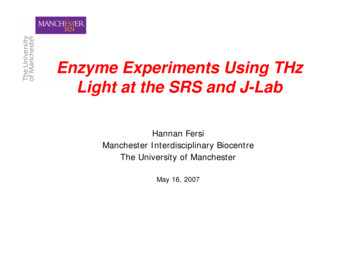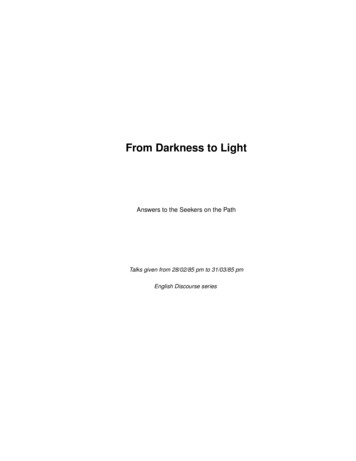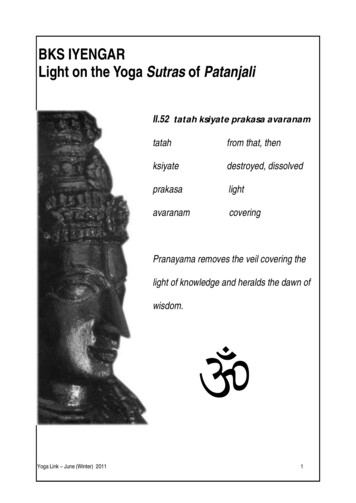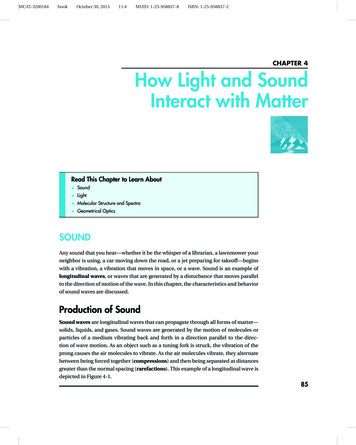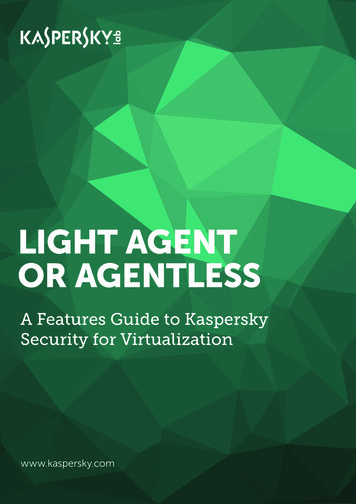
Transcription
LIGHT AGENTOR AGENTLESSA Features Guide to KasperskySecurity for Virtualizationwww.kaspersky.com
2Virtualization Security: Understanding the differenceWith virtualization becoming ever more widespread, the need foradequate security solutions is self-evident. Although just as susceptibleto cyber-attack as any physical system, virtual environments presentunique features which need consideration when assessing differentsecurity solutions.Businesses can use the same security software to protect both theirphysical and virtual machines. But while providing a good level ofprotection, standard solutions which are not designed specificallyfor virtual environments can cause problems, including:1. Excessive resource consumption due to the replication ofsignature databases and active anti-malware engines on eachprotected Virtual Machine (VM).2. “Storms”– simultaneous database updates and/or anti-malwarescanning processes on each VM, leading to an avalanchelike increase in resource consumption, causing drastic lossof performance and even denial of service. Attempts tomitigate the problem by scheduling these processes generates“vulnerability windows” – time periods when postponedmalware scans leave the VM vulnerable to attack.3. “Instant-on gaps”. Signature databases cannot be updatedon inactive VMs. So from machine startup until the updateprocess completes, the VM is vulnerable to attack.4. Incompatibilities. Because standard solutions are not built tohandle virtualization-specific features, like migrating VMs ornon-persistent storage, their use can cause instabilities andeven system lockups.Recognizing the importance of virtual systems security, and theunique features virtualization presents, market leader VMwaredeveloped vShield endpoint technology, a specific defensive layerfor its vSphere virtualization platform. This layer creates an integratedsecurity space for third-party solutions, natively integrated withVMware APIs such as vShield Endpoint and NSX Guest Introspection,enveloping all virtualized assets and allowing easy and efficient accessby appropriately designed security solutions. Only one SecurityVirtual Appliance (SVA) – a specialized virtual machine carrying ananti-malware scanning engine and signature databases – is neededper host, removing this burden from individual VMs and so greatlyreducing resource consumption. The biggest benefit of this approachfor Enterprise businesses is smooth and native integration with the
3Virtualization Security: Understanding the differenceVMware ecosystem.Another approach is an API-independent or, rather, a virtualizationplatform-independent solution, which utilizes a lightweight agentoptimized to operate inside the OS of each VM being protected.With the file scanning engine and databases still held centrally onthe SVA, ‘light agent’ technology delivers a dramatically smallerresource footprint than a traditional full agent solution. The solutionsits between “agentless” and traditional full agent solutions in termsof resource consumption, but is not tied to or limited by VMwaretechnologies and can also be used on popular platforms includingMicrosoft Hyper-V, Citrix XenServer and KVM.VMVMLIGHTER SECURITY AGENTSVMVMVMVM
4Virtualization Security: Understanding the differenceKASPERSKY SECURITY FORVIRTUALIZATION AGENTLESSKaspersky Security for Virtualization Agentless was specificallydesigned to utilize all the advantages of vShield Endpoint technology.The Security Virtual Appliance (SVA), ready for deployment out-ofthe-box, is powered by Kaspersky Lab’s award-winning anti-malwareengine, benefiting from superior detection rates and performance.Support for the cloud-assisted Kaspersky Security Network serviceensures the fastest possible reaction times and, importantly, identifiesnew malware threats in as little as 0.02 seconds. This enablesKaspersky Security for Virtualization to protect your virtualizedenvironment against even zero-day threats.VMware NSX-enabled environments benefit from integration betweenKaspersky Security for Virtualization Agentless and VMware’s nativeNSX Guest Introspection, so your infrastructure will scale with nolimitations while your security solution seamlessly follows topologyand infrastructure changes.KASPERSKY SECURITY FOR VIRTUALIZATION AGENTLESSKasperskySecurity CenterKSNKSCVMVMVMVMDISTRIBUTED SWITCHVCENTER SERVERvSpherevSphereSVANABVSHIELD OR NSX MANAGERvSphere
5Virtualization Security: Understanding the differenceFor advanced network protection, a second SVA may be used todeliver Kaspersky Network Attack Blocker functionality, in closeintegration with VMware’s vCloud Networking & Security component.There are shortcomings to an ‘agentless’ approach. First, VMwarevSphere is the only virtualization platform with an intermediatesecurity layer - vShield endpoint. For other virtualization platforms,the security solution must install some form of agent inside the guestOS of individual VMs to perform file-scanning tasks at machine level.Secondly, due to VMware’s design, native technologies like vShieldEndpoint and NSX Guest Introspection don’t provide access to theVM’s internal processes, applications or web traffic, or to virtualizeddevices. Infrastructure protection is limited to file level scanning, whichsignificantly decreases the solution’s ability to provide deep protectionagainst advanced malware at individual VM level.
6Virtualization Security: Understanding the differenceKASPERSKY SECURITY FORVIRTUALIZATION LIGHT AGENTA ‘light agent’ approach overcomes these limitations. With the filescanning engine and databases still held centrally on the SVA, thisapplication has a dramatically smaller resource footprint than traditionalfull agent solutions. The light agent on each VM provides access toindividual machine memory, application and internal processes, as wellas to web traffic and virtualized devices. This access allows advancedsecurity techniques to be deployed at machine level, while preservingoverall virtualization platform efficiency and performance.Kaspersky Security for Virtualization Light Agent has been specificallydesigned for virtual environments and supports most popular platforms:Citrix XenServer, Microsoft Hyper-V, VMware and most recently KVM.KASPERSKY SECURITY FOR VIRTUALIZATION LIGHT AGENTKasperskySecurity CenterKSNKSCVMVMVMVMVMSVAVIRTUALIZATION PLATFORM MANAGEMENTvSphereXenServerKVM
7Virtualization Security: Understanding the differenceIn virtualized server environments, Kaspersky Security for Virtualization Light Agent users benefit from valuable technologies like HIPS (HostBased Intrusion Prevention System) and a proprietary Firewall, givingprotection from network attacks. For VDI environments, security isextended with comprehensive network protection capabilities and a fullset of endpoint controls - allowing you not just to protect your systemsfrom malware, but to limit the use of untrusted applications, devices orweb resources. The solution architecture significantly reduces the attacksurface, saving precious computing resources. A powerful multi-layereddefensive perimeter, capable of eliminating sophisticated malwareand even zero-day threats, is supplemented by Automatic ExploitPrevention (AEP) technology.A ‘light agent’ approach means you can secure your virtualenvironment – including virtual servers and VDI - with no significantimpact on hypervisor performance. So you fully protect your systemsand sensitive corporate data while preserving machine density andquality of user experience.
8Virtualization Security: Understanding the differenceKASPERSKY PROTECTIVETECHNOLOGIES VS. THREATS TOYOUR VIRTUAL INFRASTRUCTUREVMs are every bit as vulnerable as their physical counterparts –perhaps even more so: in lightning-fast virtualized networks,the spread of infection can be devastating. So it’s important to identifythe security weaknesses in your virtual infrastructure, and to deployan efficient security solution with specific protection to fight advancedthreats. Below, we examine potential threats to virtual systems,and the technologies used to counteract them.Malware executablesWhether it’s an insidiously crafted attachment received via email,infected leisureware or a temporary malware-created executable – antimalware protection is essential deal with basic threats. Our powerfulmalware-fighting engine is the core of both our Agentless and LightAgent configurations of Kaspersky Security for Virtualization, thoughdifferent means are used to reach into the protected VM’s file.Another way to prevent malware agents from harming your virtualizedassets is through Application Control with Dynamic Whitelisting. Whenonly trusted software is allowed to run on a VM, malware has no chanceof executing. Kaspersky Security for Virtualization Light Agent allowsendpoint controls, including Application Control, to be enabled onindividual VMs.Bodiless malwareSome sophisticated malware does not have a ‘body’ – so there’s nothingto be found in the file system. Spawned by a previously launchedexecutable, or injected via an exploit, this malware can rarely be detectedby traditional anti-malware solutions. Advanced anti-malware techniques,which can monitor processes in the memory and immediately blockprograms engaged in any suspicious or dangerous activity, are required.Kaspersky Security for Virtualization Light Agent is armed with a rangeof technologies able to block incursions into the VM’s memory. Theseinclude: System Watcher, which monitors program behavior, tracingsystem events. Behavioral Stream Signatures, identifying behavior patternscharacteristic of malware activity.
9Virtualization Security: Understanding the difference Privilege Control, restricting application from making unsolicitedchanges, including process injection.These tools allow the Host-based Intrusion Protection System (HIPS) totrack down and stop rogue processes in the VM memory.ExploitsThe exploitation of vulnerabilities found in systems components andpopular applications remains a highly effective attack mechanism.Though it is possible to thwart these incursions using the technologiesabove, the affected program may operate at a high privilege level,limiting control over its activities.The most effective method of tackling this form of threat is to preventexploits from exploiting their targeted vulnerabilities. To swiftly overcomethe dangers posed by unpatched vulnerabilities, Kaspersky Security forVirtualization Light Agent offers Automatic Exploit Prevention (AEP)technology. AEP specifically monitors the most frequently targetedapplications in critical environments like VDI – including Adobe Reader,Internet Explorer, Microsoft Office, Java and many more – delivering anextra layer of security monitoring and protection against unknown threats.The efficiency of this technology has been proven in independent testsperformed by MRG Effitas institute, which found that, even with allother protective components switched off, Kaspersky’s AEP technologyremained 100% effective against exploit-using attacks (see Real WorldEnterprise Security Exploit Prevention, MRG Effitas, March 2015 for details).Even unknown, zero-day exploits are blocked by this superior technology.RootkitsSophisticated malware is often capable of hiding itself, preventingdetection by traditional anti-malware with the help of so called“bootkits” and “rootkits”. These insidious tools try to boot or executethe malware as early as possible, so that it gains high privileges withinthe guest operating system, helping it remain undetected.Operating both in memory and at file system level, Kaspersky Securityfor Virtualization Light Agent uses Kaspersky Lab’s Anti-Rootkittechnology to detect and eradicate even this deeply hidden malware.
10Virtualization Security: Understanding the differenceNetwork attacksNetwork-based cyber threats may allow the attacker to obtaincrucial information about the network, gaining access to the targetedsystem’s resources, interfering with critical processes and affecting itssmooth operation. These threats include malicious actions like portscanning, denial-of-service attacks, buffer under-run attacks. Bothour ‘agentless’ and ‘light agent’ solutions have network protectiontechnologies built-in. Kaspersky Security for Virtualization Light Agentextends network protection capabilities with built-in HIPS (Host-basedIntrusion Prevention System) and additional proprietary technologies tofight external and internal network attacks – including threats that maybe hidden in non-transparent virtualized traffic.Kaspersky Security for Virtualization Agentless also addresses thisissue, leveraging VMware integration to provide a Network AttackBlocker – a dedicated virtual appliance designed to monitor networktraffic for signs of typical attack activity.Malicious websitesOne of the most common sources of infection is a malicious, orinfected, website. Though this rarely affects virtualized servers, itmay pose a serious threat to VDI, a fact not always fully appreciatedby corporate users. This is where Kaspersky Lab’s web protectiontechnologies come into play.Anti-phishing prevents users from accessing websites reported asdangerous, using information obtained via the Kaspersky SecurityNetwork (KSN) and continuously updated with the help of millionsof KSN’s voluntary participants around the globe. As yet undiscoveredphishing sites are also blocked, thanks to a heuristic engine thatanalyzes the source text of the loaded page, detecting signs ofmalicious code. Web Control lets you manage Internet usage, so youcan block access to social networks, music, video, non-corporateweb email and any websites that contain inappropriate content orare against your corporate policy. You can deploy different policiesreflecting different responsibilities, and choose between applyinga complete block or just blocking access during specific periods.
11Virtualization Security: Understanding the differencePeripherals-based attacksTraditionally, one of the most effective methods of introducingan infection into an IT network is through external storage. Whilenetwork-delivered infections now appear the greater threat in termsof sheer numbers, external storage remains a significant danger –especially when it’s part of a carefully planned targeted attack. It isworth mentioning that ungoverned non-storage peripherals can alsopose a threat - external storage drives are one of the most popularmethods of stealing your confidential data. While it may not be easyfor an unauthorized person to access the physical machines hostingyour virtual infrastructure, it is possible.So hardware connecting to your virtualized environment shouldbe a concern. For example, using thin-clients is a best practice forVDI deployments, and even simplest thin-clients have USB ports.Controlling peripherals can be nightmare – or can be done seamlesslyusing Kaspersky Lab’s Device Control technology. This technologyallows you to specify which removable devices are granted access toindividual VMs, so it’s easy to apply control policies covering a rangeof devices, including removable drives, printers and non-corporatenetwork connections.Data leakageSecrets leaking from a corporate IT environment may harm notonly business-critical processes or systems but the entire business,including reputational damage that may have long-lasting and painfulconsequences. So restricting the number of ways information is sharedis a good option to protect your business.Both Kaspersky Lab’s Application Control and Device Control are usefulhere. Application Control can prevent dangerous applications, such asinstant messengers or file hosting and P2P client apps, from executingon the secured VM, while Device Control restricts the use of externalstorage, which could be used to steal sensitive data. Both technologiesare included in Kaspersky Security for Virtualization Light Agent.
Agentless or light agent: which is better?The answer depends on which virtualization platform or platforms youutilize, and specific deployments. Regardless of the hypervisor used tobuild your virtualized environment – VMware vSphere, Citrix XenServer,Microsoft Hyper-V or KVM – you can protect your critical virtualservers and fast-growing VDI with Kaspersky Security for Virtualization Light Agent. But you may also consider Kaspersky Security forVirtualization Agentless for non-critical VMware-based servers whichdo not require strong multi-layered security.Luckily, Kaspersky Security for Virtualization licensing policy allowsyou to deploy the most appropriate approach to each part of yourvirtualized environment – ‘agentless’, ‘light agent’ or a combination ofboth - under single license.Whatever combination of Citrix XenServer, VMware vSphere, KVM orMicrosoft Hyper-V virtualization platforms, and whichever approachyou are using, all your virtual and physical machines, as well as mobilesecurity, can be managed simply and centrally through a single unifiedinterface – Kaspersky Security Center. And utilizing our cloud-basedsecurity service – Kaspersky Security Network – allows for almostinstant detection of advanced threats.Twitter.com/KasperskyKaspersky Lab, Moscow, Russiawww.kaspersky.comFacebook.com/KasperskyAll about Internet nd a partner near you:www.kaspersky.com/buyoffline2016 Kaspersky Lab. All rights reserved. Registered trademarks and service marks are the property of their respective owners.
For advanced network protection, a second SVA may be used to deliver Kaspersky Network Attack Blocker functionality, in close integration with VMware’s vCloud Networking & Security component. There are shortcomings to an ‘agentless’ approach. First, VMware vSphere
